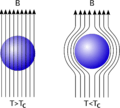Diamagnetism facts for kids
Diamagnetism is a special kind of magnetism. It's when a material very weakly pushes away a magnet. Most things around you are actually diamagnetic, even if you don't notice it. This effect is usually very weak. It was first noticed in 1778. People saw that metals like bismuth and antimony were pushed away by a magnet.
Contents
What is Diamagnetism?
Diamagnetism is a property of all materials. It makes them create a magnetic field. This field works against an outside magnetic field. Think of it like a tiny pushback. This pushback is very small. It is often hidden by stronger types of magnetism.
How Does Diamagnetism Work?
Inside every atom are tiny particles called electrons. These electrons are always moving. Their movement creates tiny magnetic fields. Normally, these tiny fields point in all different directions. They cancel each other out.
When you bring a magnet near a diamagnetic material, something changes. The magnet's field affects the electrons. It makes them move in a slightly different way. This change creates a new, weak magnetic field. This new field always pushes against the magnet you brought close.
Examples of Diamagnetic Materials
Many common materials are diamagnetic. You might not realize it because the effect is so weak.
Water
Did you know that water is diamagnetic? This means water can be pushed away by a strong magnet. You won't see your drinking water float away. But in very powerful magnets, this effect can be seen.
Bismuth and Pyrolytic Carbon
Some materials show diamagnetism more strongly. Bismuth is one example. It was one of the first materials where diamagnetism was observed. Another strong diamagnetic material is Pyrolytic carbon. This special type of carbon can even float above magnets. This is because its diamagnetic push is strong enough to overcome gravity.
Superconductors
The strongest form of diamagnetism is found in superconductors. These are materials that have zero electrical resistance at very low temperatures. When a superconductor becomes super, it completely pushes out any magnetic field. This is called the Meissner effect. It makes superconductors perfect diamagnets. This is why superconductors can float above magnets. They can also make magnets float above them.
Diamagnetic Levitation
Because diamagnetic materials push away magnets, they can be made to float. This is called magnetic levitation. It needs a very strong magnetic field.
Levitating a Frog
Scientists have used incredibly strong magnets to levitate objects. They have even levitated a live frog! This experiment showed that living things are mostly water. Since water is diamagnetic, the frog could be pushed up by the powerful magnet. The frog was not harmed during this experiment. It simply floated in the air. This shows how powerful diamagnetism can be with the right tools.
Images for kids
-
Diamagnetic material interaction in magnetic field.
-
Transition from ordinary conductivity (left) to superconductivity (right). At the transition, the superconductor expels the magnetic field and then acts as a perfect diamagnet.
-
A live frog levitates inside a 32 mm (1.26 in) diameter vertical bore of a Bitter solenoid in a magnetic field of about 16 teslas at the Nijmegen High Field Magnet Laboratory.
See also
 In Spanish: Diamagnetismo para niños
In Spanish: Diamagnetismo para niños




